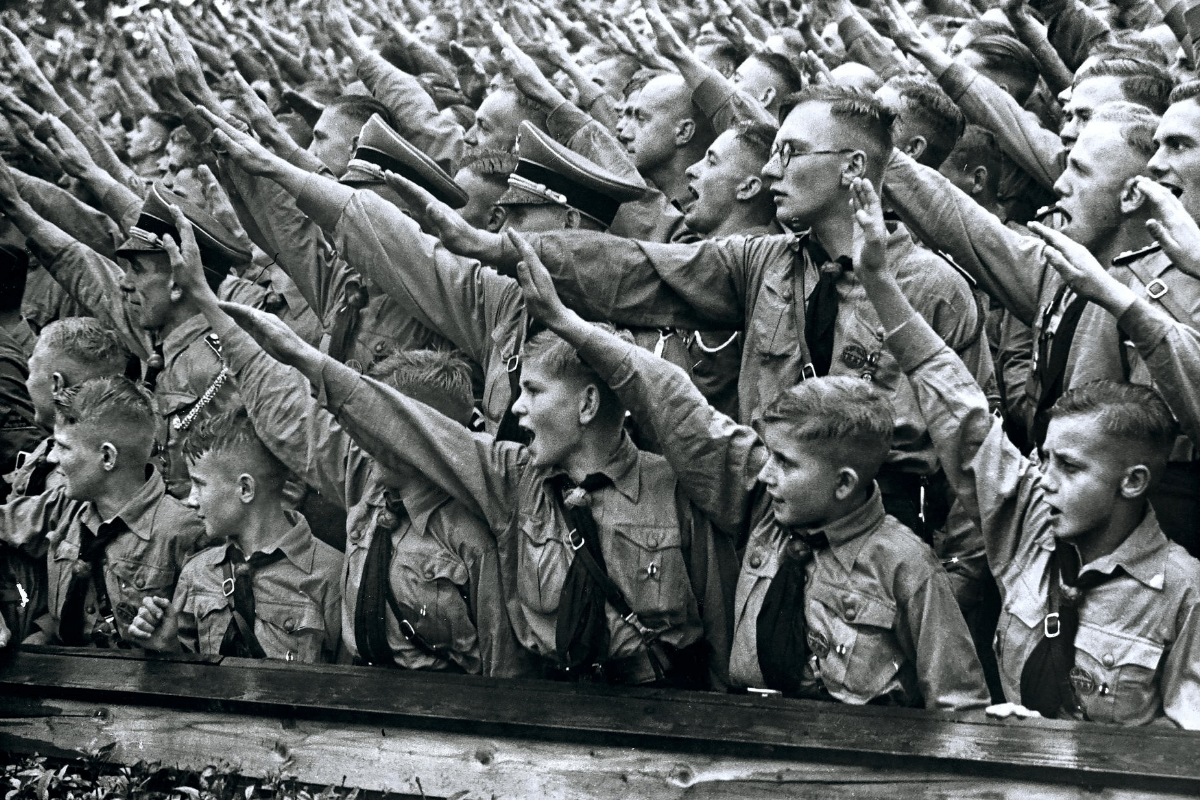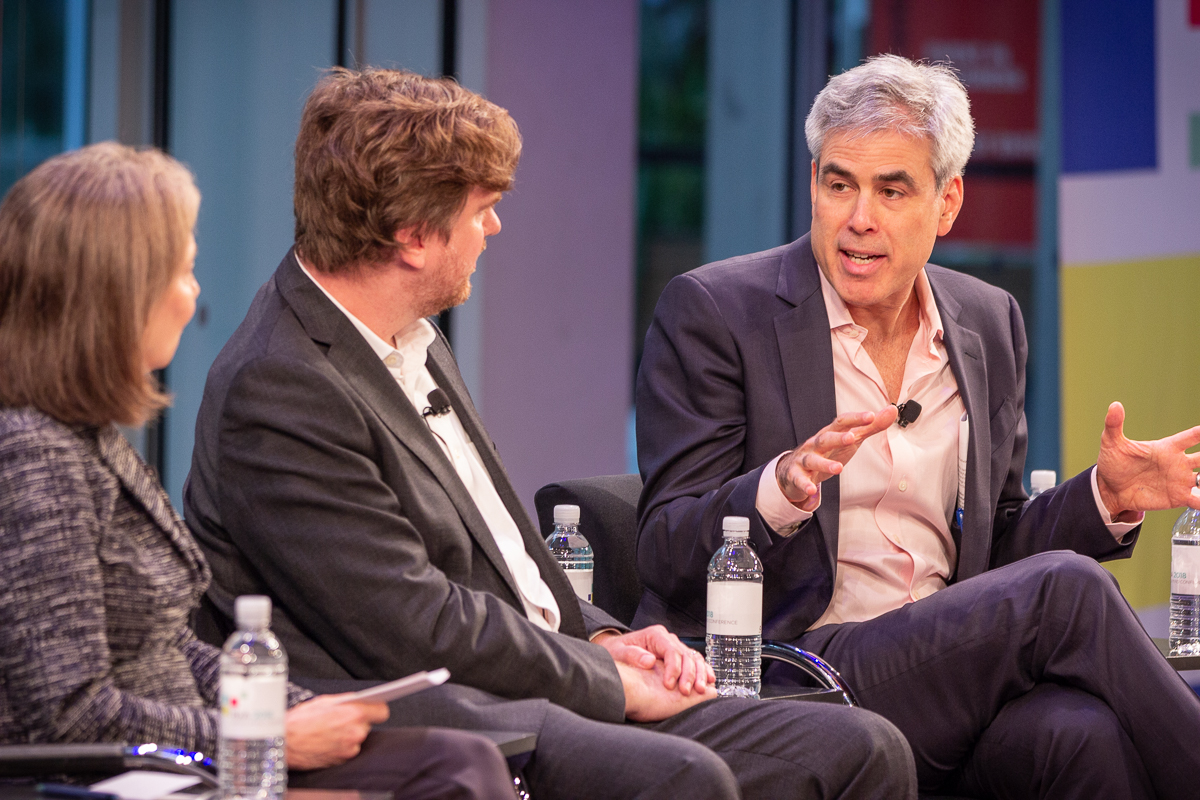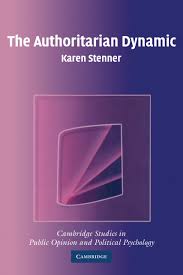History
Understanding Totalitarianism
Totalitarian regimes begin in mass movements, but it should be noted that not all mass movements are totalitarian. The American Civil Rights movement was a mass movement and undoubtedly a hugely positive force for urgently needed change.

In recent years, amid concern about a possible resurgence of totalitarianism, a number of books and articles have appeared that are intended to warn about the rhetoric and behavior of the populist Right. At the same time, a countercurrent of public intellectuals and journalists have leveled similar accusations at the radical Left, alleging illiberal motives, ideas, and tactics for influencing culture and politics. Alarm about both of these developments can be found across the political spectrum.
A sense of proportion is important when discussing this topic. For all its problems, America does not seem to be on the brink of a totalitarian revolution. Its institutions have been stressed during Trump’s term in office, but they have proved to be remarkably robust. And while there has been a concerning resurgence of radical leftwing activism in the months following the death of George Floyd, the Democratic Party’s presumptive nominee for American president is a political moderate. And, although the pandemic provides unique challenges for the election in November, the country remains a constitutional republic of laws and a peaceful handover of power (should the Democrats win) remains likely.
Nevertheless, American politics and culture have been roiled by profoundly troubling developments in recent years that have destabilized the nation, undermined its self-confidence, and further divided an already polarized population. Disaffection, distrust, and despair offer the ideal conditions for a possible totalitarian resurgence, and demagogues will not hesitate to exploit them if they can. So while it is important to avoid catastrophizing, it is also important not to lapse into complacency.
In what follows, I will offer an overview of totalitarian movements that examines why they rise and how they operate once they assume power. This will, I hope, provide an illustration of the habits of mind and of rhetoric of which Americans should remain wary in this precarious moment. The United States is still a young country, and Americans would do well to remember that a constitutional republic is by no means the natural order of things and should not be taken for granted.
* * *
Totalitarianism is most accurately defined as the idea that exercising control and direction over every aspect of the lives of a society’s inhabitants will yield the best of all possible futures. For totalitarianism to succeed in establishing itself, two preconditions are required. The first is widespread psychological dispositions that make society susceptible to totalitarianism’s temptations. The second is the skillful use of manipulative propaganda. Once put into practice, totalitarianism is a ruthless, all-encompassing socio-political force, intolerant of loyalty to anything but itself. This is the antithesis of the constitutional republics and parliamentary democracies that are the models of modern Western government.

Totalitarian regimes begin in mass movements, but it should be noted that not all mass movements are totalitarian. The American Civil Rights movement was a mass movement and undoubtedly a hugely positive force for urgently needed change. Mass movements typically coalesce around political or cultural narratives and causes that draw people together from broad segments of a national population. In The Origins of Totalitarianism, Hannah Arendt observed that the masses have very little in common in terms of interests or politics, but that a mass movement can bind diverse groups of people together with common goals and grievances. In practice, however, it is not always easy to distinguish a totalitarian from a benign mass movement at inception.
The main distinction between the two is in the all-consuming nature of the totalitarian variant. The Nazi movement aimed to deprive the people of any facet of life outside of an exclusive commitment to its mission. In fact, the Nazis, the Bolsheviks, the Maoists, and the Jacobins all sought to radically remake society by compelling every last individual to become nothing more than a cog in their revolutionary machines. Any life outside of political life was seen, by the movements’ elite leaders, as not only superfluous but suspect and as a challenge to the movements themselves. Even morality and reason are subordinate to the cause. It has often been said that such movements subordinate means to ends, but this misses the subtle point that when all means are “justified,” justification itself becomes irrelevant. So, for totalitarians, reason itself is subordinate to the cause, not merely morality. This, by and large, does not seem to be the case in modern American political movements, but at the margins of society, this kind of thinking does seem to be on the rise. If non-totalitarian mass movements are analogous to religious or spiritual organizations, then totalitarian movements resemble cults.

Eric Hoffer began his book The True Believer: Thoughts on the Nature of Mass Movements by pointing out that all mass movements are partly born of a desire for change in personal and social circumstances—totalitarian movements are no different. The individuals who are most susceptible to joining mass movements are characterized by loneliness, hopelessness, self-disdain, disappointment, and boredom. People who are contending with those kinds of feelings are initially attracted to the novelty and excitement of a mass movement, and quickly come to identify in it those aspects of their lives that are missing. In societies accustomed to progress, people who are actively dissatisfied with their personal and professional lives are especially susceptible.

In his book A People’s Tragedy: The Russian Revolution 1891–1924, Orlando Figes pointed out that, for the revolutionaries, the most appealing thing about joining the revolution was not the promise of improving society, but rather the “sense of ‘wholeness’ which might give higher meaning to their lives and end their alienation from the world.” Arendt likewise noted that mass movements thrive in societies that have experienced social atomization because this laid the groundwork for “self-abandonment into the mass” and “the passionate inclination toward the most abstract notions as guides for life.” An appealing mass movement creates the chance for the disaffected individual to lose the unhappy person that they are and remake themselves anew as a part of a seemingly benevolent mission.
Hoffer’s observation about the individual’s susceptibility to mass movements can be understood with reference to much of the literature on human behavior in the social sciences. Humans are social creatures, but we also have strong tribal tendencies. It turns out that how we self-identify is closely related to the cultural groups with which we associate. In his essay “The Dangers of Tribalism,” the philosopher of science Kevin deLaplante argues that our ideas, knowledge, and values are largely shaped by our individual sense of tribal belonging, and it’s this perception of belonging to particular groups that provides the context from which we draw much of our self-esteem as individuals.

One of the most relevant forms of tribal identity to have emerged in America in recent decades is partisan identity. In her book Uncivil Agreement: How Politics Became Our Identity, Lilliana Mason argued that partisan identity is more important to individual partisans than the actual issues. In fact, partisans often maintain their political identities in the face of contradictory policy positions. In the US, competing partisan identities have grown increasingly divergent since the 1980s as citizens have been sorting themselves into mutually exclusive geographical and cultural tribes. Marc Hetherington and Jonathan Weiler show in their book Prius or Pickup that it is possible to predict how someone votes simply by looking at a handful of seemingly unrelated preferences. For example, Republicans are more likely to live in rural areas, drive pick-up trucks, drink pilsners, listen to country music, prefer dogs to cats, watch wrestling, and prefer meatloaf to pad thai. They prefer that children be well-mannered rather than curious. Democrats are more likely to live in cities, drive hybrids, drink local beer, listen to hip-hop, have pets on their furniture, watch basketball, and eat bibimbap. They are more likely to prefer that children be independent than to show respect for their elders.

In The Righteous Mind, Jonathan Haidt argued that liberals and conservatives predictably utilize different sets of moral values. Liberals are much more attuned to the moral values of caring and fairness while conservatives more frequently include the moral senses of sanctity, loyalty, and authority. On the standard personality test known as “OCEAN,” liberals tend to be much more open to new experiences, while conservatives tend to be much more driven to perform their work well and thoroughly. The accumulated differences between these two groups amount to an inability for conservatives and liberals to relate to one another. What’s worse is that the lack of common culture has led partisans to develop an increasing level of mutual hostility and distrust. In the social psychology literature, this is known as social polarization or affect polarization.

A permanent feature of democracy accounts for much of what is potentially threatening about America’s relative political ineffectiveness as well as its fascination with social discord. In The Authoritarian Dynamic, Karen Stenner argues that about a third of people in Western liberal democracies have an authoritarian personality. People with this personality profile exhibit strong preferences for “unity and conformity” in society. They want society to believe in the same values and norms and they are avoiders of complexity. This type of personality is manifest in intolerant behaviors and attitudes, activated by perceived threats to “unity and conformity” in society. Accordingly, exposing authoritarians to a diversity of beliefs and the failure of political leadership to inspire the confidence of the citizenry, makes them less tolerant of any kind of differences in society. When authoritarians are experimentally exposed to news of social discord, they are much more likely to favor banning dissident political speech and to crack down on immigration.
This is a source of danger for democratic governments, which depend for their legitimacy upon the consent of the governed. Distrust in government as well as in the institutions of society allows totalitarian movements’ propaganda to thrive. Any information that is mysterious, hidden, secret, or granted attention by mainstream society offers a potential basis for totalitarian propaganda. Disaffected people want to escape from reality, but they also yearn for a consistent narrative—a desire that can be satisfied by movement leaders peddling paranoia and intrigue. It can be the inner workings of the Democratic National Committee or explanations for disparities in outcomes and other forms of potential social injustice.
* * *
Totalitarian leaders prey upon societal divisions like these and share an understanding of the power of simple, emotive messages repeated ad nauseam. This consideration helps shape their political rhetoric. Whenever Lenin sought to appeal to the masses, he employed the simple slogan, “bread, peace, and land.” One of Hitler’s popular mantras was “one people, one realm, one leader.” Mao used the phrase “a few years of hard work and 10,000 years of happiness” to describe the sacrifices required by his disastrous plan known as “The Great Leap Forward.” These simple messages were specifically aimed at the masses—they were designed, in the first instance, to capture the attention. Once they had the individual’s attention, they could draw him into the movement. In Mein Kampf, Hitler explained:
[Propaganda’s] function, like the poster, consists in attracting the attention of the crowd, and not in educating those who are already educated, or who are striving after education and knowledge, its effect for-the-most-part must be aimed at the emotions and only to a very limited degree the so-called intellect. All propaganda must be popular and its intellectual level must be adjusted to the most limited intelligence among those it is addressed to. Consequently, the greater the mass it is intended to reach, the lower its purely intellectual level will have to be… The more modest its intellectual ballast, the more exclusively it takes into consideration the emotions of the masses, the more effective it will be.
Hitler had an early and advanced understanding of political messaging, and he drew upon the example of socialist-Marxist organizations, and their “astounding skill” at utilizing propaganda. Hitler’s propaganda minister and closest confidant, Joseph Goebbels, was equally astute when it came to propaganda. Much of what Goebbels learned about propaganda seems to have come to him through one of the contemporary American intellectuals who had written the early literature on the subject, Edward Bernays.
Though propaganda has been aimed at all kinds of emotions, one variety was particularly common to totalitarian mass movements—that marked by the promise of a utopian future. Eric Hoffer likened the experience of a lonely, disconnected individual who joins a mass movement to someone who sees themselves as becoming part of a “holy cause.” You can catch a glimpse of this in Mao’s “10,000 years of happiness” which echoed Hitler’s promise of a new thousand-year Reich. And, of course, these promised lands would be a paradise for their inhabitants. In an essay entitled “Socialism and Religion,” Lenin stated that it was unimportant for the workers and peasants to share the same religious beliefs, but he went on to express his conviction that “unity in this really revolutionary struggle of the oppressed class for the creation of a paradise on earth” was what was really important.
Totalitarian leaders define what is wrong with the country and to insist that they are the only solution. As a totalitarian regime evolves and becomes increasingly powerful, it will extend and develop this mirage of exclusive problem-solving ability by destroying competing solutions and downplaying or even dismissing problems it cannot easily address. To this end, it sees all potential challenges or challengers as things that must be either culled or brought to heel. Hannah Arendt concluded that the most advanced totalitarian regimes attempt to destroy their subjects’ ability to think for themselves, so as to render them totally reliant on the regime for decision-making.
As totalitarian movements acquire power, they begin to divide their focus between recruiting new members and converting those already recruited into uncritical fanatics. To that end, the ideological message is tailored to the recipient. For outsiders, ideology takes the form of dubious persuasion, but for insiders, it’s an emotional appeal to reorganize society by creating totalitarian versions of various normal organizations. This means that the real fanatics will build up all manner of new organizations and even false versions of government institutions aimed at destroying and replacing existing ones.
Totalitarian propaganda relies on deceptive narratives and disinformation—conspiracy theories and folklore are integral components of any aspiring or ascending totalitarian movement. Totalitarian folklore involves self-mythologizing the movement and its history. For the Nazis, this included the glorification of their early, failed attempt to overthrow the Weimar Republic known as the “Beer Hall Putsch.” Maoists mythologized the “Long March”—a military retreat that covered thousands of miles. And Bolshevik propaganda used art and ceremony to transform the “October Revolution” (the coup in which the Bolsheviks seized power) into a heroic feat in the popular imagination.
But self-glorification tends to coexist in totalitarian regimes with an atmosphere saturated in paranoia. A great deal of what the Nazis did can be explained by their belief in a racist conspiracy theory known as “The Protocols of the Elders of Zion.” This was a fabricated document that purported to be the minutes of a meeting of a secret cabal of Jewish leaders, revealing a plot to take over the world and remake civilization as they saw fit. Purges and pogroms in the Soviet Union and the People’s Republic of China were also justified on the basis of conspiracy theories. Stalin blamed society’s problems on a conspiracy of Trotskyists attempting to overthrow him and institute capitalism, and he ordered show-trials of the alleged conspirators. Mao claimed that a conspiracy of “deviationists” were plotting to oust him and implement capitalism. Revolutionary France was also animated by conspiratorial suspicions that society was seeded with “enemies of the Revolution.”
Perhaps the most seductive feature of totalitarian ideologies is that they derive authority from spurious claims that they are based on scientific facts. The communist regimes in Russia and China claimed they were enacting Karl Marx’s “scientific” ideas about the supposed laws of capitalism and history. For the Nazis, “Aryan” and Jewish blood were not just figures of speech and racism wasn’t just an attitude—these were undeniable scientific facts. When Hitler began learning and practicing his public speaking, his speeches would be dusted with references to “rational” anti-Semitism and racial hatred based on “reason and facts” not emotion. Revolutionary France didn’t have much that we would, today, recognize as modern science. However, just as the Nazis and Bolsheviks would drag the good name of science through the mud, so did the Committee of Public Safety tarnish the Enlightenment and “reason.” In tragic fashion and with astonishing incoherence, the “Reign of Terror” was alleged to be conducted on behalf of Enlightenment values.
Equipped with the authority of pseudoscience, the leaders of totalitarian movements make what are assumed to be infallible predictions based on what they profess (and likely believe) to be, basic forces of nature and arithmetic. Totalitarian leaders will put the interest of proving themselves correct above what is best for the nation. During the 1891–1892 famine in Russia, some 400,000 people starved to death. Some Russians, including Leo Tolstoy, led a philanthropic effort to alleviate the suffering, but Lenin argued that there should be no relief effort because the famine was part of the natural force of history that would bring about the revolution. Humanitarian aid might cause a delay in the progress of history towards communism.
Violent revolution is usually the means by which totalitarians acquire power, and purges are the means by which that power is maintained and consolidated. The logic of totalitarian purity has a habit of consuming even its own most fanatical adherents. In this way, the all-consuming violence and paranoia of totalitarianism results in the systematic destruction of society. During the French Revolution, the masses rose against Louis XVI who attempted accommodate his subjects by introducing broad reforms. Nevertheless, he ended up under the guillotine and the benefits brought about by the end of the monarchy were soon overshadowed by the cruelty and injustice of the Reign of Terror. Mere accusations became sufficient justification for people to be executed, and before the terror finally subsided, its architects, including Maximilien Robespierre, were themselves guillotined.
Similarly, during the Cultural Revolution in China, the guilty and the innocent alike were massacred without much discrimination merely on the basis of accusations or alleged associations. Mao instructed revolutionaries to purge the government and broader society of any remaining members suspected of being capitalists or traditionalists in order to re-establish “Mao Zedong Thought” (as articulated in Mao’s “Little Red Book”) as the supreme doctrine to guide society. Mao knew that it wasn’t enough to purge political opponents and rivals, so he targeted factories and the education system too. The youth of the country, in the form of the Red Guards, took it upon themselves to execute the mass purges. Students tortured their teachers to death. Elderly people, typically associated with more traditional Chinese culture, were publicly humiliated and mercilessly beaten. Before the Revolution was over, Lin Biao, the head of the People’s Liberation Army who had compiled the “Little Red Book,” was accused of involvement in a plot to overthrow Chairman Mao and was liquidated—destroyed by the very doctrines he had helped promulgate.
The Bolshevik coup that seized power from the provisional parliamentary government was a successful attempt to halt progress towards a democratic-republican model. All other parties, including the other socialist factions, were expelled from the government at once. In the ensuing years, there were countless executions, including of those who had fought to overthrow the Czar. When Stalin took complete control of the Party and the country he began a series of ruthless and paranoid purges. Before it was over, even Leon Trotsky, a Bolshevik who oversaw many executions in his own right, and who many believed would be Lenin’s successor, was exiled and subsequently assassinated.
The Nazis’ Law for the Restoration of the Professional Civil Service was a 1933 decree prohibiting the employment (and allowing for the immediate dismissal) of government workers who were not “Aryans,” or who were identified as, or associated with, communists. The Nazis later purged rank-and-file party members. The early Nazi movement’s paramilitary organization, the Sturmabteilung (also known as the SA or “the brownshirts”) was as notorious for its terrorism and street fights as it was for its street marches. Ernst Röhm headed the SA and was a prominent and important early ally to Hitler. However, in 1925, Hitler established a new paramilitary force known as the SS, an elite battalion ultimately led by Heinrich Himmler. The SS was a death squad, but it also provided the Nazis’ fanatical militants with a competitively tiered hierarchy. In 1934, Hitler used the SS to eliminate the leadership of the SA, including his former friend Röhm, during a four-day purge known as “Night of the Long Knives.”
* * *
Totalitarian mass movements exploit disaffected, socially isolated, lonely people by offering them a sense of identity, solidarity, and purpose. Many of their earliest and most enthusiastic recruits are conformists, temperamentally predisposed to make others conform as they did. As totalitarians obtain power, this sense of purpose and desire for conformity spreads into all aspects of life, through propaganda and organization. And because reason and morality have been subordinated to the goals of the totalitarian movement, any tactic is permitted.
In America today, tribal identities increasingly shape our perception of the world. As these identities sort information, values, and beliefs, we are becoming less able to understand and live with one another. This polarization of the populace is reflected in the polarization of the political class. Consequently, governance has become highly partisan, sclerotic, and ineffective, which has led to rising cynicism and suspicion about the country’s democratic institutions and processes. Those seeking easy explanations for the country’s malaise are susceptible to conspiracy theories circulated by demagogues on the Left and the Right, amplified by social media echo chambers, and spread by ready Internet access. Identitarian politics across the political spectrum are further balkanizing an already divided country.
Meanwhile, the steep rise in unemployment produced by the pandemic and subsequent lockdowns risks exacerbating existing disaffection and loneliness. A report by Cigna in 2018 warned that loneliness in America had reached “epidemic levels.” Polling conducted by Ipso, they said, showed that almost half of American adults said that they sometimes or always feel alone. Forty-three percent of American adults said that they sometimes or always feel like their relationships aren’t meaningful and that they feel isolated from others. As COVID-19 continues to kill Americans, this concern has become even more pressing.
The accumulated literature about totalitarianism reflects humanity’s need to guard against its resurgence in view of the catastrophic damage it has caused in the past. Unfortunately, an understanding of totalitarianism, and of how it comes about, does not yield a civic blueprint for preventing it. Nevertheless, identifying and understanding a threat are necessary if not sufficient preconditions to resisting it. There is nothing inevitable about democratic backsliding, even when prevailing conditions increase a country’s vulnerability.






